 W
WThe talking catfish, Acanthodoras spinosissimus, is a species of thorny catfish found in the Amazon and Essequibo River basins, occurring in Brazil, Colombia, Guyana, and Peru. This species grows to 13.7 cm (5.4 in) in SL and can be found in the aquarium trade. This species is reported to produce toxic fluids.
 W
WThe Atlantic sawtail catshark is a little-known species of catshark, part of the family Scyliorhinidae, found in a small area of the northeastern Atlantic Ocean, centered on the Strait of Gibraltar and the Alborán Sea. It is found on or close to the bottom over the continental slope, mostly at depths of 400–600 m (1,300–2,000 ft). This shark closely resembles, and was once thought to be the same species as, the blackmouth catshark ; both are slender with a series of dark saddles and blotches along the back and tail, and a prominent crest of enlarged dermal denticles along the dorsal edge of the caudal fin. It differs subtly from G. melastomus in characters including snout length, caudal peduncle depth, and the color of the furrows at the corner of its mouth.
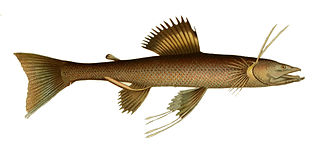 W
WThe Mediterranean spiderfish, Bathypterois dubius, a lizardfish of the family Ipnopidae, is found in the Eastern Atlantic, as well as the Mediterranean and northwest Atlantic.
 W
WThe broomtail grouper or mangrove grouper is a species of ray-finned fish from the family Serranidae which is found in the eastern Pacific along the western coast of the Americas from California to Peru.
 W
WThe brownsnout spookfish is a species of barreleye in the family Opisthoproctidae. It and the glasshead barreleye fish are the only vertebrates known to employ a mirror, in addition to a lens, to focus an image in its eyes. This species probably has a worldwide tropical and temperate distribution; in the Atlantic Ocean it is known from Bermuda, the Bahamas, the Greater Antilles, and the Gulf of Mexico, and in the Pacific Ocean it is known from the California Current region and the South China Sea. It is found in the mesopelagic and bathypelagic zones at a depth of 500–2,400 meters (1,600–7,900 ft), but usually occurs below 1,000 meters. In the Gulf of Mexico it is found shallower, at 310–460 meters (1,020–1,510 ft).
 W
WTrinorfolkia clarkei, known commonly as the Clarke's triplefin or Clarke's threefin, is a species of triplefin blenny in the genus Trinorfolkia. It was described by Alexander Morton in 1888 from specimens collected from Clarke Island in the Bass Strait. This species occurs I southern and western Australia from Camden Haven in New South Wales to Rottnest Island in Western Australia and around Tasmania. It occurs on coastal reefs and in estuaries frequently being observed around the pylons supporting structures such as jetties.
 W
WThe collared carpetshark is a poorly understood species of carpetshark of the family Parascylliidae endemic to the waters of eastern Australia between latitudes 26°S and 38°S. It is typically found 55–128 m (180–420 ft) in depth near the floor of rocky reefs on the continental shelf, though its depth range can extend between 20 and 230 m. At a maximum length of only 85 cm (2.79 ft), it poses no threat to humans. It is common within its range and is not targeted species. This, combined with high survival rates after discardment and a significant portion of habitat untouched by fishing are why it is listed as Least Concern by the International Union for the Conservation of Nature (IUCN). Reproduction is oviparous and embryos feed solely on yolk.
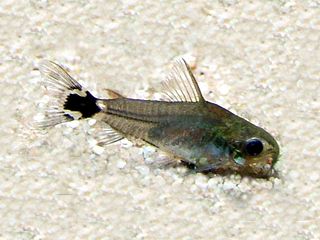 W
WThe dwarf corydoras, dwarf catfish, tail spot pygmy catfish, or micro catfish is a tropical freshwater fish belonging to the subfamily Corydoradinae of the family Callichthyidae. It originates in inland waters in South America, and is found in the Amazon River and Paraguay River basins in Argentina, Bolivia, and Brazil. The specific epithet hastatus means with a spear, in reference to the spearhead-like spot on the tail root.
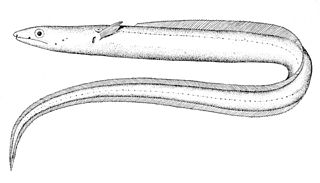 W
WEchelus pachyrhynchus is an eel in the family Ophichthidae. It was described by Léon Vaillant in 1888. It is a marine, deep water-dwelling eel which is known from the eastern Atlantic Ocean, including Morocco, Angola, Cape Verde, and Namibia. It dwells at a depth range of 200–500 metres, and inhabits burrows in mud or sand on the continental shelf. Males can reach a maximum total length of 48.5 centimetres.
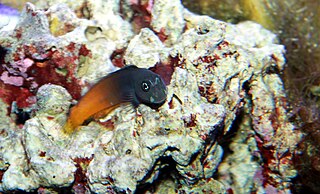 W
WEcsenius bicolor, commonly known as the flame tail blenny or bicolor blenny, is a blenny from the Indo-Pacific. It frequently makes its way into the aquarium trade. It grows to a size of 11 centimetres (4.3 in) in length.
 W
WThe freckled sea catfish is a species of catfish in the family Ariidae. It was described by Carl H. Eigenmann and Rosa Smith Eigenmann, in 1888, originally under the genus Tachisurus. It inhabits marine waters in Panama. It reaches a maximum total length of 35 cm (14 in).
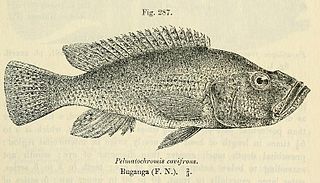 W
WHaplochromis cavifrons is a species of cichlid endemic to Lake Victoria. It is a benthopelagic fish, and is generally found a few hundred metres beyond the shore over hard substrate. This species grows to a length of 19.5 centimetres (7.7 in) SL.
 W
WHaplochromis longirostris is a species of cichlid endemic to Lake Victoria though it may now be extinct. This species can reach a length of 14.5 centimetres (5.7 in) SL.
 W
WHaplochromis nuchisquamulatus is a species of cichlid found in Lake Victoria and the adjacent reaches of the Nile. This species can reach a length of 11.3 centimetres (4.4 in) SL.
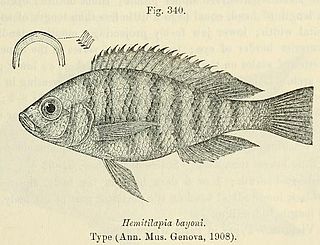 W
WHaplochromis obliquidens is an African species of cichlid found in Lake Victoria and the adjacent reaches of the Nile. This species can reach a standard length of 8.9 cm (3.5 in). Another species sometimes seen in the aquarium trade, Haplochromis latifasciatus of the Lake Kyoga system, is frequently labelled as Haplochromis "zebra obliquidens", which sometimes cause confusion between the species. Unlike that species, H. obliquidens is not known from the aquarium trade.
 W
WHolapogon maximus, the titan cardinalfish, is a species of ray-finned fish in the family Apogonidae, the cardinalfishes. This species is the only known member of the genus Holapogon. It is native to the Arabian coast and the Gulf of Oman, and it has recently been recorded from the coast of India. It lives at depths of from 83 to 100 m. This species grows to a total length of 25 cm (9.8 in).
 W
WThe Lancer dragonet, Baird's dragonet, coral dragonet or St Helena dragonet, is a species of dragonet native to the warmer waters of the Atlantic Ocean where it occurs at depths of from 1 to 91 metres. In the western Atlantic it occurs from Cape Hatteras southwards along the east coast of North America. including Bermuda and the Bahamas, into the Gulf of Mexico and throughout the Caribbean Sea. It has also been recorded from Ilha da Trindade off Brazil. In the eastern Atlantic it has been recorded from the Cape Verde Islands, Ascension Island, St. Helena, and Sao Tome e Principe in the Gulf of Guinea. This species grows to a length of 11.4 centimetres (4.5 in) TL.
 W
WThe large-toothed conger is an eel belonging to the family Congridae. It was described by Léon Vaillant in 1888, originally as a species of the genus Uroconger.
 W
WThe longfin darter is a species of freshwater ray-finned fish, a darter from the subfamily Etheostomatinae, part of the family Percidae, which also contains the perches, ruffes and pikeperches. It is endemic to the eastern United States, where it occurs in the upper James River drainage in Virginia and West Virginia. It inhabits rocky riffles of creeks and small rivers. This species can reach a length of 8.9 cm (3.5 in).
 W
WThe longnose stonebasher is a species of fish in the family Mormyridae. It is found in Burundi, the Democratic Republic of the Congo, Kenya, and Tanzania. Its natural habitats are rivers, freshwater lakes, freshwater marshes, and inland deltas.
 W
WThe giant talking catfish or giant raphael catfish is a species of thorny catfish that is native to the Amazon Basin in Bolivia, Brazil, Colombia, Ecuador and Peru. This species grows to a length of 60 centimetres (24 in) SL and a maximum weight of 4.6 kilograms (10 lb). These fish are a component of local commercial fisheries.
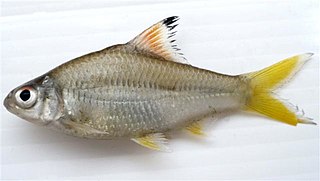 W
WMystacoleucus argenteus is a species of cyprinid fish.
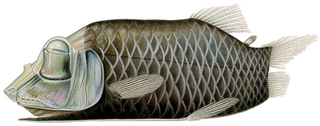 W
WOpisthoproctus soleatus is a species of fish in the family Opisthoproctidae. It was first described in 1888 by Léon Vaillant. The species lives in most tropical seas, but is more common in the eastern Atlantic, from western Ireland to Mauritania and from Sierra Leone to Angola, and also in the South China Sea. O. soleatus can grow to a standard length of 10.5 centimetres (4.1 in) and usually live from about 500 to 700 metres deep.
 W
WThe ribbon eel, also known as the leaf-nosed moray eel or bernis eel, is a species of moray eel, the only member of the genus Rhinomuraena. What is now known as R. quaesita also includes the former R. amboinensis. R. quaesita was used for blue ribbon eels and R. amboinensis for black ribbon eels, but these are now recognized as the same species. The ribbon eel is found in lagoons and reefs in the Indo-Pacific ocean, ranging from East Africa to southern Japan, Australia and French Polynesia. This species is widely distributed and is frequently seen by divers in Indonesian waters with their heads and anterior bodies protruding from crevices in sand and rubble habitats from very shallow to about 60 m. Although generally placed in the moray eel family Muraenidae, it has several distinctive features leading some to place it in its own family, Rhinomuraenidae....
 W
WThe snakeskin wrasse, also known as the slender parrotfish or slender wrasse, is a species of wrasse native to the coastal waters of southern Australia. It inhabits rocky reefs down to about 17 m (56 ft). This species grows to a standard length of 12.4 cm (4.9 in). This species is the only known member of its genus.